| . |
The processionary caterpillar
Hylesia lineata
Saturniidae
Alfonso
Pescador
Centro
Universitario de Investigacion y Desarrollo Agropecuario
Universidad
de Colima
Colima,
Mx
apescado@yahoo.com
|
|
This sexually dimorphic moth is a widely distributed tropical species that feeds on a broad diversity of hardwood species. In Mexico, preferred species are Casearia corymbosa HBK (Flacourtiaceae) and Thouinia paucidentata Radlk. (Sapindaceae). |
Hylesia lineata is
distributed
from western Mexico to Central America on the Pacific Coast.
Caterpillars
live in colonies where they display a large array of social
interactions;
they build and share communal protective shelters, defend themselves
synchronously
against predators that approach by flight, feed collectively in the
tree
crown, and form long, single-file, head-to-tail processions to travel
to
feeding sites. In the seasonal forests near Chamela, Mexico adults
first
appear in late August and egg laying occurs shortly thereafter.
The
egg complement of the female (mean = 270 eggs) is laid in a single
batch
which lies quiescent until the onset of the rainy season in June of the
following year. The newly eclosed caterpillars at first use the
felt-like
covering of the egg mass, composed of the scales of the female moth, as
a shelter, but later construct larger shelters by webbing together
leaves.
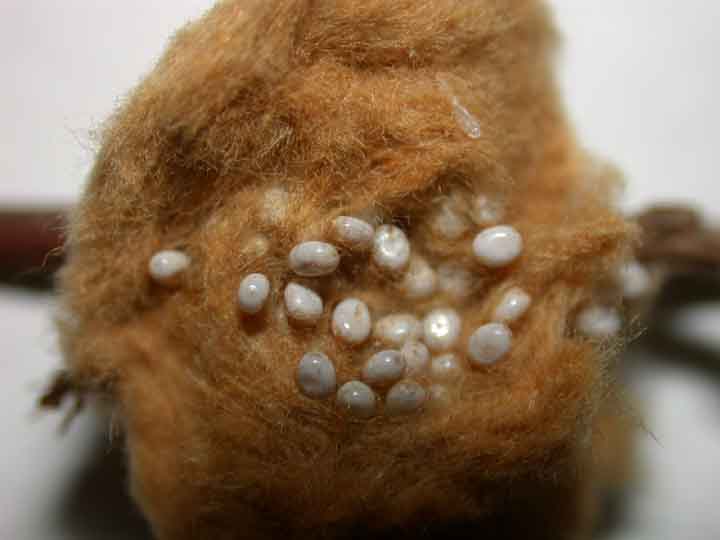 |
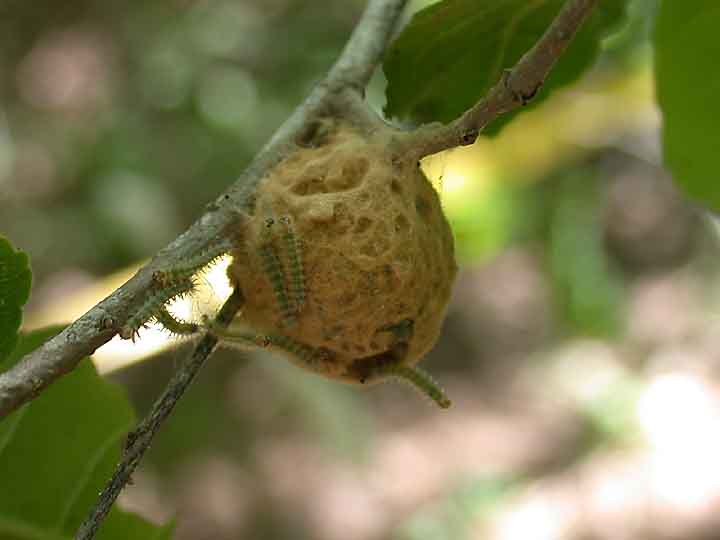 |
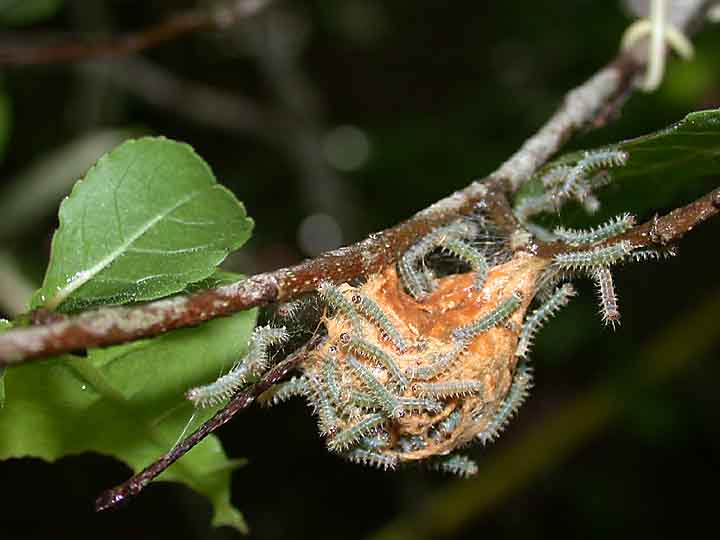 |
| It is from these shelters or, in some cases, from unsheltered aggregation sites on the leaves or stem of the tree, that the caterpillars launch nightly forays to distant feeding sites. |
 |
| The caterpillars form long, single file, head-to-tail processions as they move between their shelters and distant feeding sites. The processionary behaviour is in itself a complex set of traits that allows the caterpillars to stay together in large groups while searching for food and when travelling from their nest to feeding sites and back again. Apparently, keeping caterpillar groups together facilitates survival. Larvae are covered with highly urticating spines and when moving at unison in large numbers, they are an impressive sight that presumably deters some potential predators. | 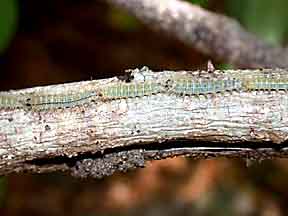 |
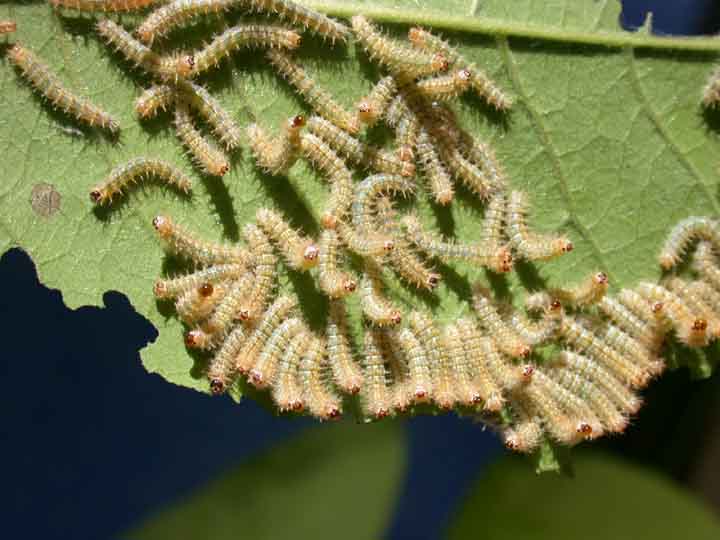 |
Keeping a group together may appear to be a difficult task. It is. This processionary lepidopteran uses a chemical marker, a pheromone, as a signal to either identify the presence of a conspecific and stay close to it, or to follow the signal if it is laid in a trail. H. lineata larvae have a set of gland-like setae on the venter of the anal segment and presumably produce the chemical marker there. Caterpillars mark a trail by dragging the anal segment against the surface they walk on. In a series of experiments it was shown that when the gland area was covered in all of the caterpillars of a group, they were unable to start a procession. However, when normal caterpillars were added to the non-marking larvae the former eventually initiated a procession and were followed by the experimental group. These experimental studies also demonstrated that silk played no significant role in trail following since the non-marking larvae were able to secrete silk. |
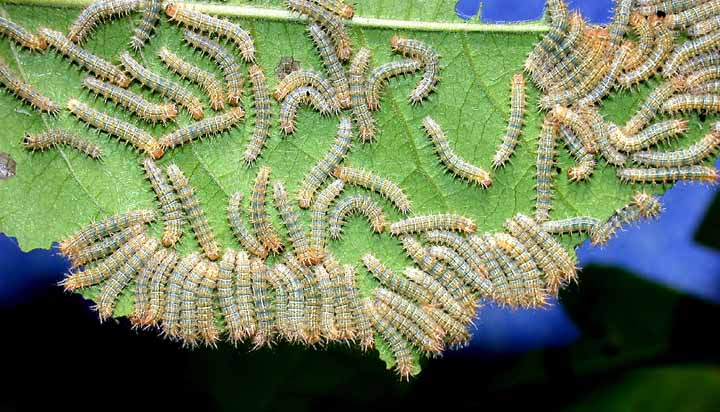 |
Caterpillars are able to distinguish between trails of different strengths. Natural variation in trail strength depends on the number of larvae in a procession. Therefore, when large processions split into smaller ones during their foraging bouts, all are able to find their way back to the nest by choosing the stronger trails. By doing so, the caterpillars stay in large groups which may be advantageous for survival. Another source of variation is trail age. In another series of experiments it was shown that trails lose strength with time. However, trails were still detectable by the caterpillars five days after deposition. The ability of the caterpillars to discriminate among trails based on trail age allows them to move efficiently to current feeding areas and to find their way back to the nest or resting site after feeding |

| Other species of Hylesia are also social but little is known of their communal foraging behavior. Hylesia acuata is particularly remarkable in that the caterpillars construct a pupal pouch from the leaves of the host tree and pupate en masse in the structure. |
 Pupal
pouch of Hylesia acuata Pupal
pouch of Hylesia acuata |
Hylesia colimatifex
is a nomadic species found in Mexico. The adults, like those of
other
species of Hylesia, have urticating hairs on their abdomen
which
are very irritating. When disturbed, the moth pulls its wings
forward
exposing its abdomen. Adults and older larvae were found near
Chamela,
Mexico in Janauary 2003.
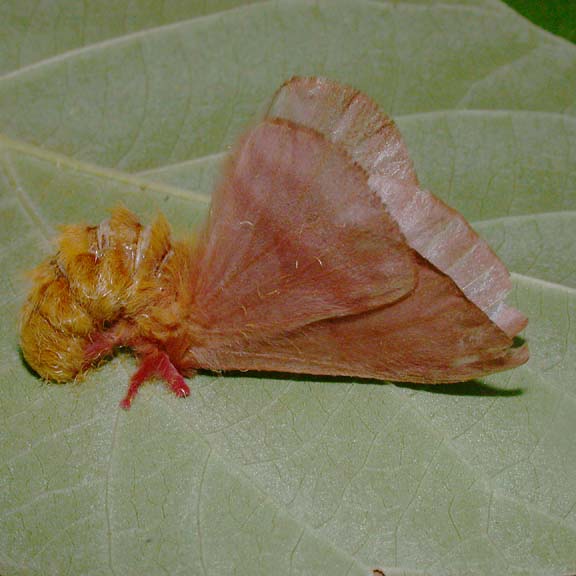 |
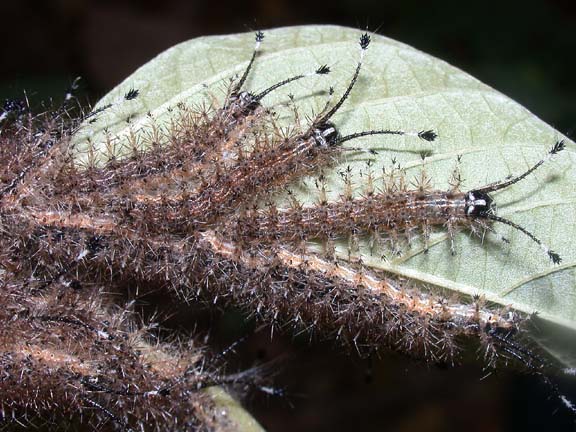 |
References
Fitzgerald, T. D. and A. Pescador-Rubio. 2002. Trail marking, trail following and source of the trail pheromone of the processionary caterpillar Hylesia lineata Druce (Lepidoptera: Saturniidae). J. Insect Behavior.
Pescador, A. R. (1993) The effects of a multispecies sequential diet on the growth and survival of a tropical polyphagous caterpillar. Entomol. exp. appl. 67: 14-24.
Pescador, A. R. (1995) Distribution and abundance of Hylesia lineata egg masses in a tropical dry forest in western Mexico. Southwest Entomol. 20: 367-375.
Janzen, D. H. (1984) Natural history of Hylesia lineata (Saturniidae: Hemileucinae) in Santa Rosa National Park, Costa Rica. J. Kansas Ent. Soc. 57: 490-514.
Wolfe, K. L. (1988) Hylesia
acuta (Saturniidae) and its aggregate pupal pouch. J.
Lepidopterists
Soc. 42: 132-137.